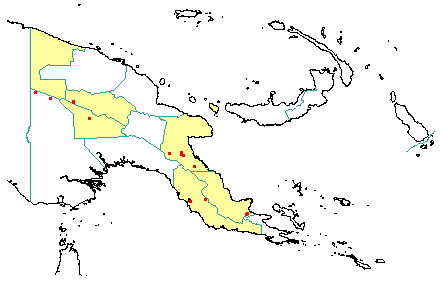
in PNGplants database
PNGTreesKey – Caldcluvia papuana (Pulle) Hoogland |
Barry Conn (NSW) & Kipiro Damas (LAE).
Guide to trees of Papua New Guinea
Copyright held by the authors, National Herbarium of New South Wales, and Papua New Guinea National Herbarium
Blumea Vol. 25 (2): 489 (1979)
Family: Cunoniaceae
Dicotyledon
Timber Group: Non-timber species
Field Characters: Large canopy tree (occasionally up to 26 m high) or Small sub-canopy tree (up to 10 m high); Bole cylindrical (up to c. 40 cm diam.); straight; buttresses buttresses present (slightly as low foot-buttresses) or buttresses absent; spines spines absent; aerial roots aerial roots absent; stilt roots stilt roots absent; Bark usually cream-coloured, pale green, grey, or brown (pale mixture of all colours when patchy), slightly rough or smooth, slightly fissured or slightly cracked; Subrhytidome (under-bark) green; less than 25 mm thick, 10.0; bark blaze consisting of one layer; faintly to non-aromatic; outer blaze white or red (turning yellow-brown on exposure), markings absent, fibrous; inner blaze white or red, markings absent, fibrous; bark exudate (sap) absent; terminal buds not enclosed by leaves.
Indumentum: Complex hairs absent; stinging hairs absent; mature twig indumentum (hairs) present (soon deciduous), hairs dense.
Leaves: Leaves spaced along branches, opposite (in pairs, opposite one another on the branchlet), compound (a leaf made up from two or more leaflets) (leaf consisting of 5- to 7-leaflets); petiole present, not winged, attached to base of leaf blade, not swollen; leaves with three leaflets (trifoliate) or pinnate (unbranched with more than three leaflets); petiolule not swollen; rachis absent (when 3-foliate) or present, absent, absent; leaves with a terminal leaflet (the number of leaflets odd - imparipinnate), broadest at or near middle (leaflets with margin entire to slightly serrate), 9.0-12.0 cm, 3.0-4.5 cm, leaflets alternate, asymmetric, terminal developing leaflet buds straight; venation pinnate, secondary veins open, prominent, intramarginal veins absent; leaves lower surface green, upper surface dark green (glossy), indumentum (hairs) absent; absent; domatia absent; stipules present, free, laterally placed, not encircling the twig, leafy, not fringed, large (reddish green), persistent.
Flowers: Inflorescence axillary, flowers on a branched axis, cones absent; flowers bisexual, stalked (shortly), flowers with many planes of symmetry, 2.0 (c.) mm long, diameter small (up to10 mm diam.) (c. 2 mm diam.); perianth present, with distinct sepals and petals whorls, inner perianth red; 5, free; stamens 10, present, free of each other, free of the perianth; ovary superior, carpels joined (when more than one), locules 2; styles free, 2.
Fruits: Infrutescence arranged on branched axis, fruit 5.0 (c.) mm long, dark red, not spiny, non-fleshy, simple, dehiscent, follicle; seeds 40 (c.), to about 5 mm long (2-2.5 mm long), winged, narrow (longer than wide), seed less than 1 mm diam. (c. 0.5 mm diam.).
Distribution: West Sepik, Morobe, Western Highlands, Southern Highlands, Central & Northern.
 | Botanical records in PNGplants database |